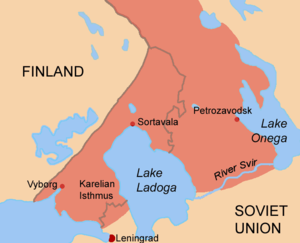
The Continuation War, also known as the Second Soviet-Finnish War, was a conflict fought by Finland and Nazi Germany against the Soviet Union from 1941 to 1944, as part of World War II. In Soviet historiography, the war was called the Finnish Front of the Great Patriotic War. Germany regarded its operations in the region as part of its overall war efforts on the Eastern Front and provided Finland with critical material support and military assistance, including economic aid.

Paavo Juho Talvela was a Finnish general of the infantry, Knight of the Mannerheim Cross and a member of the Jäger movement. He participated in the Eastern Front of World War I, the Finnish Civil War, the Finnish Kinship Wars, the Winter War and the Continuation War.

The Finnish Army is the land forces branch of the Finnish Defence Forces. The Finnish Army is divided into six branches: the infantry, field artillery, anti-aircraft artillery, engineers, signals, and materiel troops. The commander of the Finnish Army since 1 January 2022 is Lieutenant General Pasi Välimäki.

The Vyborg–Petrozavodsk offensive or Karelian offensive was a strategic operation by the Soviet Leningrad and Karelian Fronts against Finland on the Karelian Isthmus and East Karelia fronts of the Continuation War, on the Eastern Front of World War II. The Soviet forces captured East Karelia and Viborg/Viipuri. After that, however, the fighting reached a stalemate.
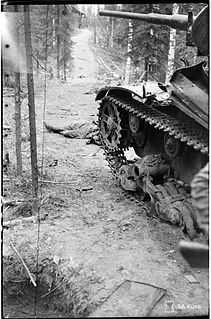
The Battle of Ilomantsi was a part of the Svir–Petrozavodsk Offensive of the Continuation War (1941–1944). It was fought from 26 July to 13 August 1944, between Finland and the Soviet Union in an area roughly 40 kilometers wide and 30 kilometers deep, near the Finnish-Soviet border, close to the Finnish village of Ilomantsi, in North Karelia. The battle ended with a Finnish victory—the last major Soviet attack against Finland was stopped here.

The Finnish invasion of Ladoga Karelia was a military campaign carried out by Finland in 1941.
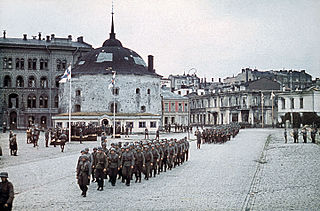
The Finnish invasion of the Karelian Isthmus refers to a military campaign carried out by Finland in 1941. It was part of what is commonly referred to as the Continuation War. Early in the war Finnish forces liberated the Karelian Isthmus. It had been ceded to the Soviet Union on 13 March 1940, in the Moscow Peace Treaty, which marked the end of the Winter War. Later, in the summer of 1944, the Soviet Union reconquered the southern part of the isthmus in the Vyborg–Petrozavodsk Offensive.

The Finnish invasion of East Karelia was a military campaign in 1941. It was part of the Continuation War. Finnish troops occupied East Karelia and held it until 1944. For over a month after the outbreak of the Continuation War, the Karelian Army reinforced and prepared to resume its earlier offensive while waiting for the recapture of the Karelian Isthmus. The Soviets had prepared fortifications and brought troops to the front. When encirclements on the western shore of Lake Ladoga were resolved, the Finnish 7th Division was transferred to the junction of VI and VII Corps.
The 8th Army was a field army of the Soviet Red Army during the Second World War.
7th Division was a Finnish Army division in the Continuation War. The division was formed Savo-Karjala military province from the men in Pohjois-Savo and Pohjois-Karjala civil guard districts.
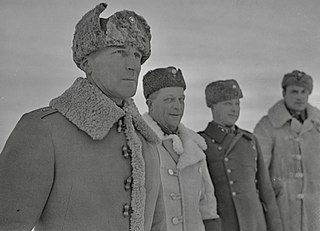
Hannu Esa Hannuksela was a Finnish Major General during World War II.

Antero Johannes Svensson was a Finnish major general, a member of the Jäger Movement and a recipient of the Mannerheim Cross. He participated in the Eastern Front of World War I as a volunteer of the 27th Royal Prussian Jäger Battalion, in the Finnish Civil War as a platoon and squadron commander, the Winter War as a brigade and division commander, and the Continuation War as a division and corps commander.
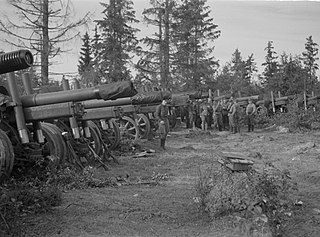
The Battle of Porlampi, also known as the Battle of Porlammi, was a military engagement fought between the Finnish Army and Red Army from 30 August to 1 September 1941 on the Karelian Isthmus. The battle was fought near the town of Porlampi during the second month of the Continuation War. The battle was a Finnish victory and effectively ended the reconquest of Karelia.

Taavetti Laatikainen was a Finnish General of Infantry and a member of the Jäger movement. He fought in the Eastern Front of World War I, the Finnish Civil War, the Winter War and the Continuation War. During the last of these, he was awarded the Mannerheim Cross of Liberty 2nd Class. Before the Winter War, he commanded both the Reserve Officer School and the Officer Cadet School. He retired in 1948 from the position of Inspector of Infantry.
The I Corps refers to several short-lived units of the Finnish Army before and during the Continuation War. The longest-lived I Corps participated in both the Finnish invasion of Ladoga Karelia and the Finnish invasion of the Karelian Isthmus in 1941 before being disbanded in early 1942, before being re-designated V Corps.

Einar Nikolai Mäkinen was a Finnish lieutenant general and a member of the Jäger movement. He participated in the Eastern Front of World War I, the Finnish Civil War, the Winter War and the Continuation War. Before the Continuation War, he participated in negotiations with the Germans regarding plans for the war.
The II Corps was a unit of the Finnish Army during the Continuation War. During the war the corps participated in combat first northwest of Lake Ladoga and on the Karelian Isthmus before moving to the Povenets–Lake Segozero region by late 1941. During the Soviet offensive of 1944, the corps conducted a fighting retreat to the region of Ilomantsi, with parts of its forces participating in the subsequent Battle of Ilomantsi.
The V Corps was a unit of the Finnish Army during the Continuation War of 1941–1944. It was first active for a brief time in 1941, and was reactivated in 1942 in the Svir sector during the trench warfare phase of the war. Following the Soviet Vyborg–Petrozavodsk offensive, the corps was moved to the Karelian Isthmus, where it fought in the Battle of Vyborg Bay, stopping a Soviet amphibious operation to cross the Vyborg Bay.
The VI Corps was a corps of the Finnish Army during the Continuation War of 1941 to 1944, where the Finnish Army fought alongside Germans against the Soviet Union. The unit was formed during a reorganization of other Finnish army corps on 29 June 1941, prior to the start of Finnish offensive operations on the night of 9–10 July.
The VII Corps was a corps of the Finnish Army during the Continuation War of 1941 to 1944, where the Finnish Army fought alongside Germans against the Soviet Union. Under command of Major General Woldemar Hägglund, it took part in the Finnish invasions of Ladoga Karelia and East Karelia, including the capture of Petrozavodsk. During its existence, its composition varied significantly. It was disbanded in May 1943.
